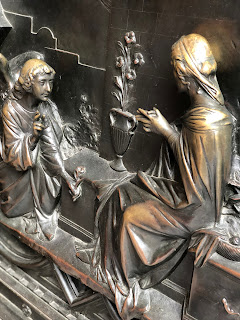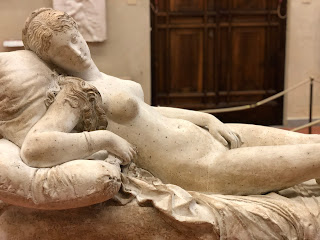.
We had a wonderful day in old Florence with my parents.
Here are some photos of our tour.
Tiny (cute) cars.
Con i miei amori!
Ponte Vecchio.
The Ponte Vecchio is a medieval stone closed-spandrel segmental arch bridge over the Arno River, in Florence, Italy, noted for still having shops built along it, as was once common. Butchers initially occupied the shops; the present tenants are jewelers, art dealers and souvenir sellers. The Ponte Vecchio's two neighbouring bridges are the Ponte Santa Trinita and the Ponte alle Grazie.
The bridge spans the Arno at its narrowest point where it is believed that a bridge was first built in Roman times, when the via Cassia crossed the river at this point. The Roman piers were of stone, the superstructure of wood. The bridge first appears in a document of 996. After being destroyed by a flood in 1117 it was reconstructed in stone but swept away again in 1333 save two of its central piers, as noted by Giovanni Villani in his Nuova Cronica. It was rebuilt in 1345.
(source: https://en.wikipedia.org/wiki/Ponte_Vecchio)
My dream: to travel in a hot air ballon!
The gang on Ponte Vecchio.
Locks for lovers.
Street art 1
Street art 2
Street art 3
Perseus with the Head of Medusa is a bronze sculpture made by Benvenuto Cellini in the period 1545-1554. The sculpture stands upon a square base with bronze relief panels depicting the story of Perseus and Andromeda, similar to a predella on an altarpiece. It is located in the Loggia dei Lanzi of the Piazza della Signoria in Florence, Italy. The second Florentine duke, Duke Cosimo I de’ Medici, commissioned the work with specific political connections to the other sculptural works in the piazza. When the piece was revealed to the public on 27 April 1554, Michelangelo’s David, Bandinelli’s Hercules and Cacus, and Donatello’s Judith and Holofernes were already erected in the piazza.
The subject matter of the work is the mythological story of Perseus beheading Medusa, a hideous woman-faced Gorgon whose hair was turned to snakes and anyone that looked at her was turned to stone. Perseus stands naked except for a sash and winged sandals, triumphant on top of the body of Medusa with her snakey head in his raised hand. The body of Medusa spews blood from her severed neck. The bronze sculpture and Medusa’s head turns men to stone and is appropriately surrounded by three huge marble statues of men: Hercules, David, and later Neptune. Cellini breathed new life into the piazza visitor through his new use of bronze in Perseus and the head of Medusa and the motifs he used to respond to the previous sculpture in the piazza. If one examines the sculpture from the back, you can see the self-image of the sculptor Cellini on the backside of Perseus' helmet.
(source: https://en.wikipedia.org/wiki/Perseus_with_the_Head_of_Medusa)
Piazza della Signoria is an L-shaped square in front of the Palazzo Vecchio in Florence, Italy. It was named after the Palazzo della Signoria, also called Palazzo Vecchio. It is the main point of the origin and history of the Florentine Republic and still maintains its reputation as the political focus of the city. It is the meeting place of Florentines as well as the numerous tourists, located near Palazzo Vecchio and Piazza del Duomo and gateway to Uffizi Gallery.
The Palazzo Vecchio ("Old Palace") is the town hall of the city. This massive, Romanesque, crenellated fortress-palace is among the most impressive town halls of Tuscany. Overlooking the square with its copy of Michelangelo's David statue as well the gallery of statues in the adjacent Loggia dei Lanzi, it is one of the most significant public places in Italy, and it hosts cultural points and museums.
Originally called the Palazzo della Signoria, after the Signoria of Florence, the ruling body of the Republic of Florence, it was also given several other names: Palazzo del Popolo, Palazzo dei Priori, and Palazzo Ducale, in accordance with the varying use of the palace during its long history. The building acquired its current name when the Medici duke's residence was moved across the Arno to the Palazzo Pitti.
(source: https://en.wikipedia.org/wiki/Piazza_della_Signoria)
Florence Cathedral, formally the Cattedrale di Santa Maria del Fiore, is the cathedral of Florence, Italy (Italian: Duomo di Firenze). It was begun in 1296 in the Gothic style to a design of Arnolfo di Cambio and was structurally completed by 1436, with the dome designed by Filippo Brunelleschi. The exterior of the basilica is faced with polychrome marble panels in various shades of green and pink, bordered by white, and has an elaborate 19th-century Gothic Revivalfaçade by Emilio De Fabris.
The cathedral complex, in Piazza del Duomo, includes the Baptistery and Giotto's Campanile. These three buildings are part of the UNESCO World Heritage Site covering the historic centre of Florence and are a major tourist attraction of Tuscany. The basilica is one of Italy's largest churches, and until the development of new structural materials in the modern era, the dome was the largest in the world. It remains the largest brick dome ever constructed.
(source:https://en.wikipedia.org/wiki/Florence_Cathedral)
The huge doors are cover in bronze, wood and marble sculptures.
Inside the Catedral - Duomo.
The humongous building is covered in marble.
I LOVE this little building.
My store in Florence. :)
Mike really wanted to see the original Michelangelo's David sculpture.
It is at the Accademia, and tickets costs only 8 euros. Very impressive!
David is a masterpiece of Renaissance sculpture created in marble between 1501 and 1504 by the Italian artist Michelangelo. David is a 5.17-metre (17.0 ft) marble statue of a standing male nude. The statue represents the Biblical hero David, a favoured subject in the art of Florence.
David was originally commissioned as one of a series of statues of prophets to be positioned along the roofline of the east end of Florence Cathedral, but was instead placed in a public square, outside the Palazzo Vecchio, the seat of civic government in Florence, in the Piazza della Signoria where it was unveiled on 8 September 1504. The statue was moved to the Galleria dell'Accademia, Florence, in 1873, and later replaced at the original location by a replica.
Because of the nature of the hero it represented, the statue soon came to symbolize the defence of civil liberties embodied in the Republic of Florence, an independent city-state threatened on all sides by more powerful rival states and by the hegemony of the Medici family. The eyes of David, with a warning glare were turned towards Rome.
(Source: https://en.wikipedia.org/wiki/David_(Michelangelo)
There is also a beautiful room full with sculptures in the same space, at the Accademia.
The Palazzo Medici, also called the Palazzo Medici Riccardi after the later family that acquired and expanded it, is a Renaissance palacelocated in Florence, Italy. It is the seat of the Metropolitan City of Florence and a museum.
The palace was designed by Michelozzo di Bartolomeo for Cosimo de' Medici, head of the Medici banking family, and was built between 1444 and 1484. It was well known for its stone masonry, which includes architectural elements of rustication and ashlar. The tripartite elevation used here expresses the Renaissance spirit of rationality, order, and classicism on human scale. This tripartite division is emphasized by horizontal stringcourses that divide the building into stories of decreasing height. The transition from the rusticated masonry of the ground floor to the more delicately refined stonework of the third floor makes the building seem lighter and taller as the eye moves upward to the massive cornice that caps and clearly defines the building's outline.
(source: https://en.wikipedia.org/wiki/Palazzo_Medici_Riccardi)
Two flowers at the Palazzo Medici's garden.
Today's version of David.
Santa Maria Novella is a church in Florence, Italy, situated just across from the main railway station named after it. Chronologically, it is the first great basilica in Florence, and is the city's principal Dominican church.
The church, the adjoining cloister, and chapter house contain a multiplicity of art treasures and funerary monuments. Especially famous are frescoes by masters of Gothic and early Renaissance. They were financed by the most important Florentine families, who ensured themselves funerary chapels on consecrated ground.
(source: https://en.wikipedia.org/wiki/Santa_Maria_Novella)
This church was called Novella (New) because it was built on the site of the 9th-century oratory of Santa Maria delle Vigne. When the site was assigned to Dominican Order in 1221, they decided to build a new church and adjoining cloister. The church was designed by two Dominican friars, Fra Sisto Fiorentino and Fra Ristoro da Campi. Building began in the mid-13th century (about 1246), and was finished about 1360 under the supervision of Friar Iacopo Talenti with the completion of the Romanesque-Gothic bell tower and sacristy. At that time, only the lower part of the Tuscan gothic façade was finished. The three portals are spanned by round arches, while the rest of the lower part of the facade is spanned by blind arches, separated by pilasters, with below Gothic pointed arches, striped in green and white, capping tombs of the nobility. This same design continues in the adjoining wall around the old churchyard. The church was consecrated in 1420.
(source: https://en.wikipedia.org/wiki/Santa_Maria_Novella)
Our last visit of the day was at the Michelangelo Piazza, on top of the hill.
From there, you have the best view of Florence... and a great sunset.
This Florentine piazza was designed by architect Giuseppe Poggi and built in 1869 on a hill just south of the historic center, during the redevelopment of Oltrarno, the left (South) bank of the Arno river. In 1869, Florence was the capital of Italy and the whole city was involved in an urban renewal, the so-called "Risanamento" or the "Renovation" of the city's neighborhoods. Lungarni (riverside walkways; "lungarno", singular) were built on the riversides. On the right bank, the fourteenth-century city walls were removed and turned into the Viali di Circonvallazione, mimicking the French "boulevard" design, six lanes wide and lined with trees. On the left bank winding up the hill of San Miniato the Viale dei Colli was built, a tree-lined street over 8 kilometers long ending at the Piazzale Michelangelo which was built as a terrace with a panoramic view of the city.
The square, dedicated to the Renaissance sculptor Michelangelo, has bronze copies of some of his marble works found elsewhere in Florence: the David and the four allegories of the Medici Chapel of San Lorenzo. The monument was brought up by nine pairs of oxen on 25 June 1873.
Poggi designed the loggia in the neoclassical-style that dominates the whole terrace, which today houses a restaurant. Originally it was intended to house a museum of works by Michelangelo, never realized. In the wall of the balcony, under the loggia, there is an epigraph in capital letters referring to his work: Poggi turned this into his monument in 1911.
The view captures the heart of Florence from Forte Belvedere to Santa Croce, across the lungarni and the bridges crossing the Arno, including the Ponte Vecchio, the Duomo, Palazzo Vecchio, the Bargello and the octagonal bell tower of the Badia Fiorentina. Beyond the city are the hills of Settignano and Fiesole.
The Piazzale Michelangelo can be accessed by car along the tree-lined Viale Michelangelo, constructed at the same time, or by walking the stairs or going up the ramps from the Piazza Giuseppe Poggi, also known as the "Poggi Ramps" in the district of San Niccolò.
(source: https://en.wikipedia.org/wiki/Piazzale_Michelangelo)










































No comments:
Post a Comment